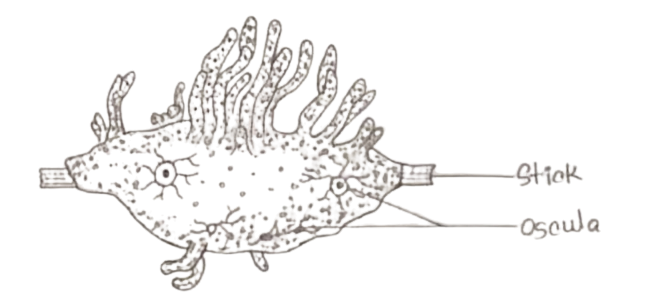Spongilla is a common, widely distributed freshwater sponge belonging to the family Spongillidae in the subclass Monaxonida. Spongilla lacustris is the most abundant species. S. fragilis is also a common species.
The Systematic Position of Spongilla
| Kingdom: | Animalia |
| Phylum: | Porifera |
| Class: | Demospongiae |
| Order: | Spongillida |
| Family: | Spongillidae |
| Genus: | Spongilla |
| Species: |
Spongilla lacustris
|
Spongilla Diagram

Habit and Habitat of Spongilla
1. Spongilla is a genus of freshwater sponges in the family Spongillidae.
2. They are found in lakes, ponds, and slow streams.
3. They are sessile organisms.
4. They attach themselves to rocks, logs, and sometimes to the ground.
5. They filter the water for various small aquatic organisms such as protozoans, bacteria, and other free-floating pond life.
6. Usually they are yellowish-brown in color.
7. Sometimes they take part in symbiotic relationships with green algae zoochlorellae.
Food and Feeding of Spongilla
1. It is a filter feeder animal.
2. They filter-feeding based on pumping ambient water through an intricate system of aquiferous canals that intersperses the body.
3. When the water flowing through the incurrent canals enters a choanocyte chamber, flow velocity decreases drastically and suspended particles are deflected toward the microvilli of the choanocytes.
4. The microvilli collar acts as a sieving basket retaining particles transiently on its external side until they are subsequently phagocytosed by distal and lateral pseudopodia of the choanocyte.
5. By this mechanism, Spongilla retains viruses, bacteria, and cyanobacteria.
Breeding / Reproduction of Spongilla
Spongilla reproduces asexually as well as sexual methods.
Asexual reproduction
-
-
- Spongilla has three types of asexual reproduction methods. The methods are fragmentation, budding, and by producing gemmates.
- The principal method is fragmentation.
- Very few species reproduce by budding.
- Gemmules are asexual reproduction cell groups that form when extremely cold, drought, or other conditions threaten a sponge’s life.
- Gemmules resist dying, freezing, and oxygen depletion. Even if a sponge doesn’t survive, its gemmules do.
- When conditions improve, the gemmules regenerate into a new sponge.
-
Sexual Reproduction
-
-
- An egg and sperm form a single cell that grows into a larva.
- The larva is known as a tadpole larva.
- The larva swims around and eventually attaches to a solid surface such as rocks, logs, or any other hard particles and develops into an adult sponge.
-
Economic Importance of Spongilla
- They are generally unpalatable due to their unpleasant taste.
- The Romans used them for painting.
- Some even used them to absorb fluids to be drunk later on.
- They were also used as cushions and furniture.
- In glass manufacture, sponges are used in wiping and cleaning hot glass.
- The ancient Greeks used dried, fibrous skeletons of sponges for the purpose of bathing, washing, scrubbing floors, and padding shields and armor.
————— THE END —————
Read More:
Reference:

Md Ekarm Hossain Bhuiyan is a dedicated zoology graduate with a profound passion for the study of animal life. He completed his primary and secondary education at Ispahani Public School and College, renowned for its commitment to academic excellence. He then pursued his secondary education at Government Science College. After that he achieved graduation at Department of Zoology, Jagannath University. His educational background and enthusiasm for zoology position him to make meaningful contributions to the field of biological sciences in Bangladesh.